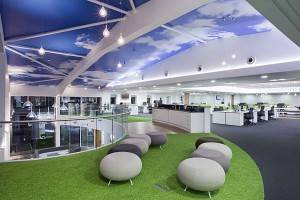 Too many companies continue to talk about employees as their ‘greatest asset’ yet their fine words are not always not borne out in their behaviour, be that through working culture, remuneration or environment. With more and more investors using employee wellness and engagement as a barometer for the health, stability and culture of the business – the concept of workplace wellbeing is finally garnering the attention it deserves. Our workplace behaviours, cultures and environments are not keeping us fit, well, productive, happy or profitable. Finally businesses are accepting their moral responsibility to take better care of their people. So what affects employee productivity, creativity and happiness and how can changes to the workplace promote the best financial and moral outcomes for businesses and employees alike?
Too many companies continue to talk about employees as their ‘greatest asset’ yet their fine words are not always not borne out in their behaviour, be that through working culture, remuneration or environment. With more and more investors using employee wellness and engagement as a barometer for the health, stability and culture of the business – the concept of workplace wellbeing is finally garnering the attention it deserves. Our workplace behaviours, cultures and environments are not keeping us fit, well, productive, happy or profitable. Finally businesses are accepting their moral responsibility to take better care of their people. So what affects employee productivity, creativity and happiness and how can changes to the workplace promote the best financial and moral outcomes for businesses and employees alike?
For many years the working week was reducing by an hour each decade but then, when the economic crisis of 2008 arrived, so too did our perceived need to work harder and longer and the working week started to increase again.
But businesses cannot rely on their people working harder and longer –we’re at capacity and can’t keep increasing the stress we put ourselves under. The focus has to be on making people more productive and efficient. It’s this ethos that has given rise to employee and workplace wellbeing – the notion that we should invest more in our assets if we are to extract more value and ultimately profitability.
All too often the idea of employee and workplace wellbeing centres on the superficial notion of happiness – the idea that smiling staff are the epitome of wellbeing. And while it’s certainly part of it, this over-focus on happiness has made some businesses nervous of the wellbeing agenda, fearful that happy staff will somehow lack focus.
 But the evidence speaks loud and clear. Companies with a strong culture have significantly less staff turnover than those without (13.9 percent for those with 48 percent for those without,according to to research from Columbia University cited in Eric Sui’s blog on ‘It really pays to have a rich company culture’ and infographic (left)). Happy employees are 12 per cent more productive than the average employee, with unhappy workers being 10 per cent less productive, according to research from Warwick University.
But the evidence speaks loud and clear. Companies with a strong culture have significantly less staff turnover than those without (13.9 percent for those with 48 percent for those without,according to to research from Columbia University cited in Eric Sui’s blog on ‘It really pays to have a rich company culture’ and infographic (left)). Happy employees are 12 per cent more productive than the average employee, with unhappy workers being 10 per cent less productive, according to research from Warwick University.
Focusing on workplace wellbeing can have the same impact as a sickness management programme and businesses supporting wellbeing are more likely to see improvements in engagement, productivity, creativity and staff retention.
This global movement for workplace wellbeing has stemmed, in part from the increased retirement age and the idea that most of us will be working for much longer. If the X and Y generations are to work into their seventies, it is vital they are fit (mentally and physically), well and competent.
After such a period of economic turbulence there is also a blanket acceptance that businesses and employees need to be more resilient. Those organisations that weathered the storm, thrived even, were flexible and nimble, reinventing themselves as market conditions changed. They were the businesses where employees were motivated, enthused and supported.
Now, as our working lives become more transitory, with up to seven careers predicted in a lifetime, the balance of power has shifted to the employee. They have more choice and will exert it, opting to work for companies that give them the best career opportunities, wellbeing and quality of life. It extends far beyond financial remuneration.
Combine these points with the fact the UK government’s own policy paper ‘health work and wellbeing’ highlights that unbearable strain workplace absence puts on the country’s economy and public resources and you can see why wellbeing is in the spotlight.
THE HOLY TRINITY OF WELLBEING
To my mind there is a holy trinity of workplace-wellbeing: culture environment and health
Company Culture
Culture stems from the organisation’s personality (from the employee’s point of view) and takes into account everything from shared purpose and objectives to working atmosphere. If the business is built on sharing ideas and collaboration, then the culture needs to support communication and socialising too. That might be through empowering staff to choose the workspace that suits them, creating more communal spaces or organising staff socials.
The best workplaces are those where workers feel engaged, share a common purpose and feel their personal contributed is recognised. Make wellbeing part of the culture rather than the latest management idea and you have the makings of a more motivated workforce straight away. Companies with a strong culture have significantly less staff turnover than those without.
Workplace Environment
Many companies have come to understand the value of creating dynamic, engaging workplaces that motivate and inspire and empowerment is certainly order of the day.
With the proliferation of mobile technology breaking the link between the place of work and the act of work, the best offices are doing away with endless rows of desks in favour of more variety, creating spaces that cater for different working styles and empower the employee to choose what’s right for them. The best workplaces bring the culture to life – they embody corporate values.
 ‘Village greens’ are popping up on office floor-plates – co-locating services such as printers, tea making facilities and breakout zones in central areas to encourage people to come together. The idea of ‘chance meetings’ improves communication and engenders a more positive and friendly working culture.
‘Village greens’ are popping up on office floor-plates – co-locating services such as printers, tea making facilities and breakout zones in central areas to encourage people to come together. The idea of ‘chance meetings’ improves communication and engenders a more positive and friendly working culture.
More thought-provoking and creative spaces provide stimulation, freedom and visual points of interest in the office too – host a brainstorm in a camper van meeting room, use a quiet pod for report writing or a video conferencing zones to avoid an arduous car journey and long day.
Spaces dedicated to wellbeing and fun deliver value – AutoTrader has a health and beauty room where visiting therapists can set up camp and employees can book treatments. A charity call centre in Bristol has two slides in the office, encouraging movement and making walking to meetings and departments something that’s guaranteed to put a smile on your face.
Social relationships are the key to heightened wellbeing and lowered stress and both are an ‘antidote for depression and prescription for high performance according to Shawn Achor, author of The Happiness Advantage. He also says: “…data now abounds showing that happy workers produce higher sales, perform better in leadership and learn higher job performance ratings and pay. Study after study shows that feelings of happiness lead people to excel in their jobs.”
Health
 It’s important to highlight the mental and physical impact that the workplace can have on how we feel and operate at work too. One in four people experience a mental health problem each year and stress at work is one of the leading causes of workplace absence.
It’s important to highlight the mental and physical impact that the workplace can have on how we feel and operate at work too. One in four people experience a mental health problem each year and stress at work is one of the leading causes of workplace absence.
Lots of workplaces try to manage health in the workplace but in a tokenistic way with ‘feel better’ quick fixes such as offering de-stress massages during working hours. Reports show that workplace stress is minimal where there is a strong social element to the company culture – an ability to talk and share concerns, meaning the old adage ‘a problem shared is a problem halved’ has never been truer. Companies with positive cultures are best placed to manage stress and, if they’re doing it right, will have created a working environment and set of values that mitigate this from the outset.
There’s no shortage of figures that say our sedentary lifestyles (at home and work) are increasing our mortality with a higher risk of obesity and cancer to name a few. The Active Working Movement has gained momentum here in the UK spreading this message and the advice is we should change our working position every 30 minutes, vary the working day by completing some tasks stood up and spend two minutes each hour walking round the office.
 In a relatively short time this has given rise to new additions to workplace design – with meeting tables at standing height and sit/stand desks which allow the user to change the height and assume a new working position at the push of a button. But it’s not just about new equipment – it’s about taking an active interest in health and wellbeing and promoting its benefits to employees. Some of the UK’s largest and most innovative employers offer initiatives such as free fruit, access to doctors and consultants during the working day, complimentary gym membership and even yoga and gym classes in the office. Used in conjunction with a positive working culture and liberating and inspiring workspaces and wellbeing starts to be addressed.
In a relatively short time this has given rise to new additions to workplace design – with meeting tables at standing height and sit/stand desks which allow the user to change the height and assume a new working position at the push of a button. But it’s not just about new equipment – it’s about taking an active interest in health and wellbeing and promoting its benefits to employees. Some of the UK’s largest and most innovative employers offer initiatives such as free fruit, access to doctors and consultants during the working day, complimentary gym membership and even yoga and gym classes in the office. Used in conjunction with a positive working culture and liberating and inspiring workspaces and wellbeing starts to be addressed.
In summary, wellbeing may sound like a watchword or phrase of the day but it is a growing boardroom concern with good reason. Employee welfare has a direct correlation to productivity, profitability and consequently share price and there are anecdotes, figures and studies aplenty to support that.
Employee and workplace wellbeing needs to be recognised for what it is – a responsibility, which is integral to a business’s operations. It is not a fad that shareholders should fear, but a strategy they should actively use across their culture and working environment to protect and grow their business.
_______________________
 Ann Clarke is joint managing director of Claremont Group Interiors
Ann Clarke is joint managing director of Claremont Group Interiors

























September 2, 2015
We need to do more than pay lip service to workplace wellbeing 0
by Ann Clarke • Case studies, Comment, Wellbeing, Workplace design
For many years the working week was reducing by an hour each decade but then, when the economic crisis of 2008 arrived, so too did our perceived need to work harder and longer and the working week started to increase again.
But businesses cannot rely on their people working harder and longer –we’re at capacity and can’t keep increasing the stress we put ourselves under. The focus has to be on making people more productive and efficient. It’s this ethos that has given rise to employee and workplace wellbeing – the notion that we should invest more in our assets if we are to extract more value and ultimately profitability.
All too often the idea of employee and workplace wellbeing centres on the superficial notion of happiness – the idea that smiling staff are the epitome of wellbeing. And while it’s certainly part of it, this over-focus on happiness has made some businesses nervous of the wellbeing agenda, fearful that happy staff will somehow lack focus.
Focusing on workplace wellbeing can have the same impact as a sickness management programme and businesses supporting wellbeing are more likely to see improvements in engagement, productivity, creativity and staff retention.
This global movement for workplace wellbeing has stemmed, in part from the increased retirement age and the idea that most of us will be working for much longer. If the X and Y generations are to work into their seventies, it is vital they are fit (mentally and physically), well and competent.
After such a period of economic turbulence there is also a blanket acceptance that businesses and employees need to be more resilient. Those organisations that weathered the storm, thrived even, were flexible and nimble, reinventing themselves as market conditions changed. They were the businesses where employees were motivated, enthused and supported.
Now, as our working lives become more transitory, with up to seven careers predicted in a lifetime, the balance of power has shifted to the employee. They have more choice and will exert it, opting to work for companies that give them the best career opportunities, wellbeing and quality of life. It extends far beyond financial remuneration.
Combine these points with the fact the UK government’s own policy paper ‘health work and wellbeing’ highlights that unbearable strain workplace absence puts on the country’s economy and public resources and you can see why wellbeing is in the spotlight.
THE HOLY TRINITY OF WELLBEING
To my mind there is a holy trinity of workplace-wellbeing: culture environment and health
Company Culture
Culture stems from the organisation’s personality (from the employee’s point of view) and takes into account everything from shared purpose and objectives to working atmosphere. If the business is built on sharing ideas and collaboration, then the culture needs to support communication and socialising too. That might be through empowering staff to choose the workspace that suits them, creating more communal spaces or organising staff socials.
The best workplaces are those where workers feel engaged, share a common purpose and feel their personal contributed is recognised. Make wellbeing part of the culture rather than the latest management idea and you have the makings of a more motivated workforce straight away. Companies with a strong culture have significantly less staff turnover than those without.
Workplace Environment
Many companies have come to understand the value of creating dynamic, engaging workplaces that motivate and inspire and empowerment is certainly order of the day.
With the proliferation of mobile technology breaking the link between the place of work and the act of work, the best offices are doing away with endless rows of desks in favour of more variety, creating spaces that cater for different working styles and empower the employee to choose what’s right for them. The best workplaces bring the culture to life – they embody corporate values.
More thought-provoking and creative spaces provide stimulation, freedom and visual points of interest in the office too – host a brainstorm in a camper van meeting room, use a quiet pod for report writing or a video conferencing zones to avoid an arduous car journey and long day.
Spaces dedicated to wellbeing and fun deliver value – AutoTrader has a health and beauty room where visiting therapists can set up camp and employees can book treatments. A charity call centre in Bristol has two slides in the office, encouraging movement and making walking to meetings and departments something that’s guaranteed to put a smile on your face.
Social relationships are the key to heightened wellbeing and lowered stress and both are an ‘antidote for depression and prescription for high performance according to Shawn Achor, author of The Happiness Advantage. He also says: “…data now abounds showing that happy workers produce higher sales, perform better in leadership and learn higher job performance ratings and pay. Study after study shows that feelings of happiness lead people to excel in their jobs.”
Health
Lots of workplaces try to manage health in the workplace but in a tokenistic way with ‘feel better’ quick fixes such as offering de-stress massages during working hours. Reports show that workplace stress is minimal where there is a strong social element to the company culture – an ability to talk and share concerns, meaning the old adage ‘a problem shared is a problem halved’ has never been truer. Companies with positive cultures are best placed to manage stress and, if they’re doing it right, will have created a working environment and set of values that mitigate this from the outset.
There’s no shortage of figures that say our sedentary lifestyles (at home and work) are increasing our mortality with a higher risk of obesity and cancer to name a few. The Active Working Movement has gained momentum here in the UK spreading this message and the advice is we should change our working position every 30 minutes, vary the working day by completing some tasks stood up and spend two minutes each hour walking round the office.
In summary, wellbeing may sound like a watchword or phrase of the day but it is a growing boardroom concern with good reason. Employee welfare has a direct correlation to productivity, profitability and consequently share price and there are anecdotes, figures and studies aplenty to support that.
Employee and workplace wellbeing needs to be recognised for what it is – a responsibility, which is integral to a business’s operations. It is not a fad that shareholders should fear, but a strategy they should actively use across their culture and working environment to protect and grow their business.
_______________________